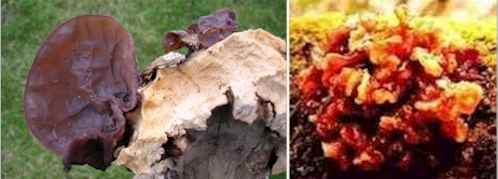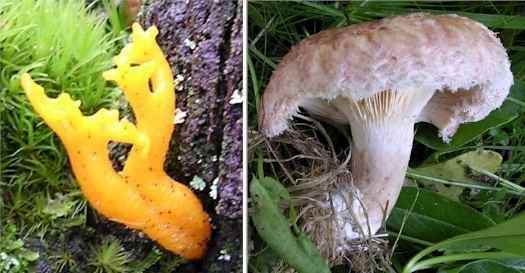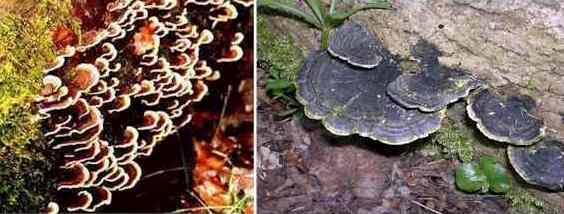..
MORE IMAGES FROM CHAPTER 2
Fig. 2.26. A mauve-brown basidiocarp of Boletus scaber (10 cm diameter), growing as a mycorrhizal associate of birch trees. The underside (right) shows that basidiospores are produced in pores, not on gills, giving rise to the common name for these fungi – the polypores. [© Jim Deacon]
Fig. 2.27. Two examples of 'jelly fungi'. Left: Basidiocarps of the brown-coloured ‘ear fungus’, Auricularia auricula (3 to 8 cm) commonly found on the branches of elder bushes (Sambucus nigra). The basidiocarps of Auricularia tolerate repeated cycles of drying and rewetting. Right: Tremella mesenterica (about 5 cm diameter) growing on a dead tree branch. Jelly fungi have several distinctive structural and ultrastructural features, including basidia that are deeply divided like tuning forks or with four long sterigmata, or with septate basidia. Some have a haploid yeast-like budding phase, and some can bud conidia from the basidiospores. [© Jim Deacon]
Fig. 2.28. An orange-yellow, forked basidiocarp of Calocera viscosa (about 5 cm high), which grows from underground decaying stump tissues of trees. Right: Basidiocarp of the salmon-pink coloured toadstool Lactarius torminosus, about 10 cm diameter. This poisonous fungus is frequently seen as a mycorrhizal associate of birch trees.It is commonly known as the woolly milk cap. [© Jim Deacon]
Fig.
2.29. Thin, leathery brackets of the polypore fungus,
Coriolus versicolor (about 5-7 mm diameter) which
often occurs abundantly on logs or fallen hardwood trees.
The brackets grow at their margins and often show
concentric zones of different colours – hence the
species name, versicolor.
Fig. 2.30. Two examples of edible gilled fungi. Left: A typical cluster of basidiocarps of Pleurotus ostreatus, the ‘oyster fungus’ (each basidiocarp is about 10 cm diameter) growing on a log. The gills are pure white, and the upper surface is mauve-brown. Right: Basidiocarps of the chanterelle, Cantharellus cibarius, which typically grows on mossy banks at the edges of birch woods.[© Jim Deacon] |
|||||||||||




